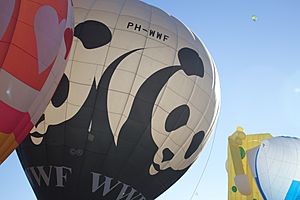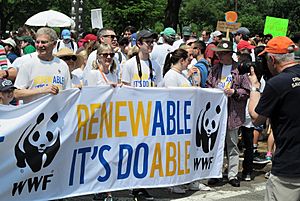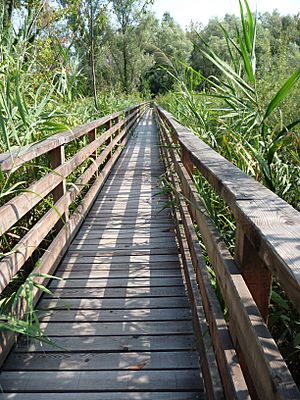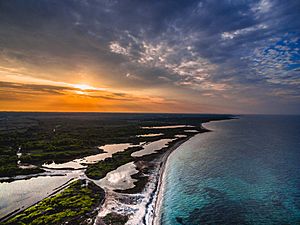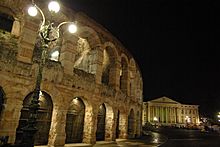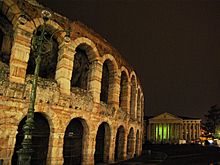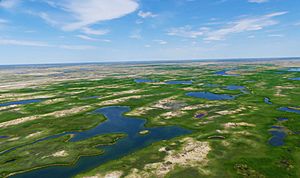World Wide Fund for Nature facts for kids

Logo used since 2000
|
|
| Abbreviation | WWF |
|---|---|
| Formation | 29 April 1961 |
| Founders |
|
| Type | International NGO |
| Purpose |
|
| Headquarters | Rue Mauverney 28 Gland, Switzerland |
|
Region
|
Worldwide |
| Methods |
|
|
President
|
Adil Najam |
|
Director General
|
Kirsten Schuijt |
|
Revenue
|
|
| Website | (US) |
| ^ b: Also WWF's first president. |
|
The World Wide Fund for Nature (WWF) is a global organization that works to protect nature. It was started in Switzerland in 1961. WWF helps save wild places and reduces the harm humans do to the environment. In Canada and the United States, it is still officially called the World Wildlife Fund.
WWF is the biggest conservation group in the world. It has over 5 million supporters and works in more than 100 countries. The organization supports about 3,000 projects that help nature and the environment. Since 1995, WWF has invested over $1 billion in more than 12,000 conservation efforts. Most of its money (65%) comes from individuals and gifts. Some funding (17%) comes from governments, and 8% comes from companies.
WWF's main goal is to "stop the damage to the planet's natural environment." They also want to "build a future where humans live in peace with nature." Every two years since 1998, WWF publishes the Living Planet Report. This report shows how human activity affects the Earth. WWF also runs big campaigns like Earth Hour. Their work focuses on six key areas: food, climate, freshwater, wildlife, forests, and oceans.
Contents
How WWF Started
The idea for a fund to help endangered animals came from Victor Stolan. He suggested it to Sir Julian Huxley. This led Huxley to connect Stolan with Edward Max Nicholson. Nicholson had experience bringing together smart thinkers and big businesses. He came up with the name for the organization.
The famous panda logo was designed by Sir Peter Scott. WWF officially began on April 29, 1961. It was first called the World Wildlife Fund. Its first office opened on September 11 in Morges, Switzerland. This was at the headquarters of the IUCN.
WWF was created to raise money internationally. This money would support other groups already working to protect nature, especially the IUCN. The start of WWF was marked by the signing of the Morges Manifesto. This document explained WWF's promise to help groups that were trying to save the world's wildlife.
They need above all money, to carry out mercy missions and to meet conservation emergencies by buying land where wildlife treasures are threatened, and in many other ways. Money, for example, to pay guardians of wildlife refuges .... Money for education and propaganda among those who would care and help if only they understood. Money to send out experts to danger spots and to train more local wardens and helpers in Africa and elsewhere. Money to maintain a sort of 'war room' at the international headquarters of conservation, showing where the danger spots are and making it possible to ensure that their needs are met before it is too late.
Prince Bernhard of Lippe-Biesterfeld helped start WWF. He became its first president in 1961. In 1963, WWF held a meeting and released an important report. This report warned about human-caused global warming.
In 1970, Prince Bernhard and Prince Philip, Duke of Edinburgh created a special fund. It was called The 1001: A Nature Trust. This fund helped manage WWF's money and fundraising. Prince Bernhard later resigned from his role.
WWF Presidents
Here is a list of the people who have led WWF as president:
| Years | Name | Country |
|---|---|---|
| 1961–1976 | Prince Bernhard of Lippe-Biesterfeld | |
| 1976–1981 | John Hugo Loudon | |
| 1981–1996 | Prince Philip, Duke of Edinburgh | |
| 1996–1999 | Syed Babar Ali | |
| 2000 | Ruud Lubbers | |
| 2000–2001 | Sara Morrison | |
| 2001–2010 | Chief Emeka Anyaoku | |
| 2010–2017 | Yolanda Kakabadse | |
| 2018–2022 | Pavan Sukhdev | |
| 2023–present | Adil Najam |
Recent Work and Changes
WWF has opened offices and started projects all over the world. At first, it mainly raised money and gave it to other groups. It focused on protecting endangered species. As WWF got more resources, its work grew. It started helping with things like saving biological diversity, using natural resources wisely, reducing pollution, and dealing with climate change. The organization also began running its own conservation projects and campaigns.
In 1986, the organization changed its name to World Wide Fund for Nature. It kept the WWF initials. However, in the United States and Canada, it continued to use the original name.
The year 1986 was WWF's 25th anniversary. To celebrate, a meeting was held in Assisi, Italy. Prince Philip, the Duke of Edinburgh, invited religious leaders from different faiths. These leaders created "The Assisi Declarations." These statements showed the spiritual connection between their followers and nature. This led to more involvement from religions in conservation worldwide.
In the 1990s, WWF updated its mission statement. It aimed to:
Stop the degradation of the planet's natural environment and to build a future in which humans live in harmony with nature,
- conserving the world's biological diversity;
- ensuring that the use of renewable natural resources is sustainable; [and]
- promoting the reduction of pollution and wasteful consumption.
WWF researchers found 238 special ecoregions around the world. These are places with the most amazing plant and animal life on land, in freshwater, and in the oceans. In the early 2000s, WWF focused its work on some of these ecoregions. They worked on protecting forests, freshwater, and ocean habitats. They also focused on saving endangered species, fighting climate change, and getting rid of harmful chemicals.
We shan't save all we should like to, but we shall save a great deal more than if we had never tried.
In 2023, Adil Najam became the president of WWF International. He is a climate scientist and expert from Pakistan. His appointment shows how important climate change and human well-being are to WWF's plans.
Conservation Foundation
The Conservation Foundation was started in New York City in 1947 by Fairfield Osborn. It helped fund scientific research on global conservation issues. This group did not get involved in politics. In 1985, it became connected with WWF. By 1990, it fully joined WWF.
Conservation Foundation in the United States
The group now known as the Conservation Foundation in the United States used to be the Forest Foundation of DuPage County. In 1996, this organization gained special status from UNESCO.
Panda Symbol
WWF's giant panda logo came from a panda named Chi Chi. She was moved from the Beijing Zoo to the London Zoo in 1958. This was three years before WWF started. Chi Chi was famous because she was the only panda in the Western world at that time. Her unique look and her status as an endangered species made her perfect for WWF's symbol. The organization needed a strong, recognizable symbol that everyone could understand, no matter what language they spoke. They also needed an animal that would look good in black and white printing.
Sir Peter Scott designed the logo. He used early drawings by Gerald Watterson, a Scottish naturalist. The logo was simplified in 1978 and then made even simpler in 1986. This was when the organization changed its name. The updated version had solid black shapes for the eyes. In 2000, the font used for the letters WWF in the logo was changed.
How WWF Works
Making Decisions
WWF's policies are made by board members. These members are chosen for three-year terms. An executive team helps guide and develop WWF's plans. There is also a national council that advises the board. A team of scientists and experts does research for WWF.
Laws and rules play a big part in how natural places and resources are managed. Making sure these laws are good and followed is a top priority for WWF.
WWF has spoken out against getting oil from the Canadian tar sands. They have campaigned on this issue. From 2008 to 2010, WWF worked with The Co-operative Group. They published reports that said:
- Using all the Canadian tar sands could cause "runaway climate change."
- Technology to capture carbon (CCS) cannot reduce carbon dioxide as much as other oil extraction methods.
- The money spent on tar sands could be better used for renewable energy research.
- More tar sands extraction seriously threatens caribou in Alberta.
The organization works to convince governments to create, follow, and improve laws that protect nature and natural resources. They also make sure governments keep their promises to international agreements about protecting nature.
In 2012, David Nussbaum, the head of WWF-UK, spoke against how shale gas is used in the UK. He said the government should focus on renewable energy and energy efficiency.
Working Together
WWF works on many global problems that cause nature to be lost or resources to be used unsustainably. These include saving species, managing money, business practices, laws, and what people choose to buy. Local offices also work on issues in their own countries or regions.
WWF partners with many different groups to reach its goals. These include other non-profit organizations, governments, businesses, banks, scientists, fishermen, farmers, and local communities. They also run public campaigns to influence decision-makers. WWF tries to teach people how to live in a more environmentally friendly way. They ask people to donate money to protect the environment. Donors can sometimes receive gifts in return.
In October 2020, WWF became a partner for Prince William's Earthshot Prize. This prize looks for solutions to environmental problems. In March 2021, WWF announced they would continue their partnership with H&M. This partnership focuses on making supply chains more sustainable.
Key Projects and Programs
Campaigns
- Debt-for-Nature Swap: A way to reduce a country's debt in exchange for environmental protection.
- Earth Hour: A worldwide event where people turn off their lights for one hour to show support for climate action.
- Healthy Grown: A program that helps farmers grow food in ways that are better for the environment.
- Marine Stewardship Council: An organization that sets standards for sustainable fishing.
Publications
WWF publishes the Living Planet Index with the Zoological Society of London. This index, along with calculations of the ecological footprint, helps create the Living Planet Report every two years. This report shows how human activities affect the world. In 2019, WWF and Knorr released the Future 50 Foods report. It listed "50 Foods for Healthier People and a Healthier Planet." In 2018, WWF, TRAFFIC, and IFAW started the Coalition to End Wildlife Trafficking Online with 21 tech companies.
WWF also regularly publishes reports and fact sheets. These documents raise awareness and provide information to leaders about their work.
Promotions
- No One's Gonna Change Our World was a music album released in 1969 to benefit WWF.
- Peter Rose and Anne Conlon are writers who create environmental musicals for children. WWF-UK asked them to write several musicals as part of an education plan. Some were narrated by David Attenborough and shown on TV in many countries.
- The British pop group S Club 7 were ambassadors for WWF-UK from 1999 to 2003. Each member sponsored an endangered animal. In 2000, they traveled to different places to see their chosen animals for a BBC documentary series called S Club 7 Go Wild.
- Environmentally Sound: A Select Anthology of Songs Inspired by the Earth was a benefit album released in 2006 for WWF-Philippines.
- In June 2012, WWF launched an online music store with fairsharemusic. 50% of the profit from downloads goes to the charity.
- In April 2015, Hailey Gardiner released her solo EP, The Woods. 15% of the money from the EP sales was donated to WWF to honor Earth Day.
Environmental Education
From 1997 to 2007, WWF's office in China ran its Environmental Educators' Initiative. This program trained thousands of teachers. It also set up environmental education centers at universities for teachers. This work helped shape the Chinese Ministry of Education's guidelines for environmental education in public schools in 2003.
Regional Organizations
WWF-Australia
WWF-Australia started on June 29, 1978, in Sydney. It had three staff members and a budget of about $80,000 for the first year. This included a $50,000 grant from the government. As of 2020, WWF-Australia is the largest conservation organization in the country. It runs projects across Australia and the wider Oceania region. Between 2019 and 2024, WWF-Australia reported an average income of $57 million per year. In 2024, WWF-Australia had an income of $52.2 million (AUD) and 138.9 full-time staff.
In 1990, WWF-Australia created the national Threatened Species Network (TSN) with the government. This network worked until 2009. In 1999, it helped create the Environment Protection and Biodiversity Conservation Act. This was one of the most complete biodiversity conservation laws in the world at the time. Since then, WWF-Australia has managed many conservation programs. One example is bringing black-flanked rock-wallabies back to Kalbarri National Park in Western Australia.
Fundación Vida Silvestre Argentina
In Argentina, WWF is represented by Fundación Vida Silvestre Argentina. This is an independent organization that is also part of the WWF network.
See also
 In Spanish: Fondo Mundial para la Naturaleza para niños
In Spanish: Fondo Mundial para la Naturaleza para niños
- Centres of Plant Diversity
- Conservation movement
- Environmental movement
- Global 200, special ecoregions identified by WWF for conservation
- List of environmental organizations
- Natural environment
- Sustainability
- Sustainable development
- Traffic (conservation programme), a joint program of WWF and the International Union for Conservation of Nature (IUCN)
- World Conservation Award, an award created with WWF





